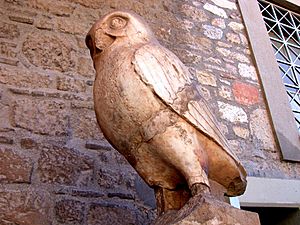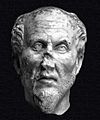Ancient philosophy facts for kids
Ancient philosophy is about the big ideas and ways of thinking from long, long ago. It includes the thoughts of people from ancient places like China, Greece, Rome, India, and Iran. These places had large empires before 200 BC. This period is sometimes called the Axial Age, because it was a time when many important new ideas appeared around the world.
Thinking in Ancient Greece and Rome
In Europe, when we talk about ancient philosophy, we mostly mean the ideas from Ancient Greece and Ancient Rome. These thinkers asked deep questions about life, the universe, and how we should live.
A scholar named Diogenes Laërtius, who lived in the 3rd century, wrote a book called Lives and Opinions of Eminent Philosophers. This book summarized the ideas of many famous Ancient Greek philosophers. It was translated into Latin, which helped keep these ideas known even after the famous Library of Alexandria lost its importance.
After the 6th century, much of ancient philosophy was forgotten in Europe. However, these ideas were kept alive and studied by thinkers in the Islamic world, like Avicenna (who lived in the 11th century) and Averroes (12th century). A Jewish philosopher named Maimonides (12th century) also helped share these ancient ideas.
Later, during the Middle Ages in Europe, scholars like Albertus Magnus (13th century) and Thomas Aquinas (13th century) rediscovered and studied the works of ancient thinkers, especially Aristotle. This helped bring ancient philosophy back into the spotlight.
Images for kids
-
Raphael's School of Athens, showing many ancient Greek philosophers talking.
-
Vyasa, in the middle of the picture.
-
Zarathustra, as shown in Raphael's The School of Athens, next to Raphael himself, who appears as the ancient painter Apelles of Kos.
See also
 In Spanish: Filosofía antigua para niños
In Spanish: Filosofía antigua para niños







